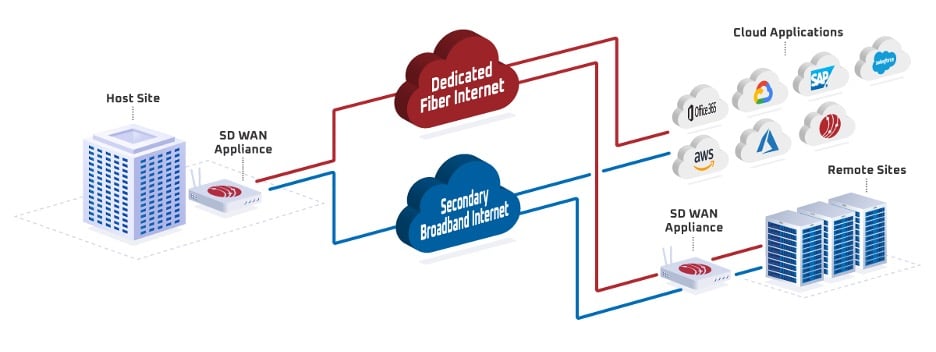The rapid adoption of cloud computing continues to usher businesses all over the world into new levels of functionality, communication and collaboration. Gone are the days of obtaining and installing traditional and costly hardware for every additional application or location. Centrally-managed virtual networks, like SD-WAN, keep geographically dispersed workforces connected over secure, reliable internet like never before.
What is SD-WAN?
SD-WAN, which stands for software-defined wide-area network, adds a layer of intelligence that provides real-time control and visibility over network and application performance. Businesses with several locations and/or remote employees can stay connected virtually through SaaS and IaaS applications instead of backhauling all traffic to a brick-and-mortar headquarters, which inherently monopolizes bandwidth and slows productivity.

What are the benefits of SD-WAN?
- Boosted Connectivity
- Redundancy
- Centralized Management
- Security
- Cost-Savings
- Easy Deployment
IDG’s 2020 State of the Network Study found that 71 percent of organizations are either actively researching SD-WAN or have it in production. It’s no surprise that so many businesses flock to this continually emerging technology. It provides ample benefits and advantages for any business environment.
Benefit: Boosted Connectivity
SD-WAN can combine broadband internet (fiber, cable and DSL), MPLS, DSL, 4G – basically any type of network operated by any provider – to increase your bandwidth and boost your connectivity. Utilizing all types of WANs, including private WANs, can drastically improve upload and download speeds and markedly improve overall network performance.
SD-WAN’s augmented bandwidth becomes increasingly attractive as the business-critical applications we use become more technologically advanced. Legacy networking technologies might not be able to support today’s sophisticated SaaS tools, and SD-WAN is an easy way to “grow” your network.
Furthermore, some solutions’ built-in features like load-balancing and dynamic routing enhance quality of service (QoS) by segmenting traffic and prioritizing applications such as real-time video.
Benefit: Redundancy
The same SD-WAN-enabled fiber/broadband bundling and intelligent load balancing that boosts connectivity also delivers redundancy and resiliency. Whether it’s primary-and-secondary failover or multiple failover options for guaranteed network uptime, SD-WAN provides potent business continuity solutions.
Benefit: Centralized Management
SD-WAN solutions provide easy-to-use interfaces for centralized monitoring and control. Administrators can control and prioritize traffic and set parameters for acceptable use. Not only does this visibility give the business more control of their internet traffic, but it also reduces the burden on local resources. Furthermore, the management platform likely offers a multitude of data points and analytics that can assist in network decision-making and mitigate networking challenges and threats.
Benefit: Security
The centralized management capabilities of SD-WAN solutions also are an advantage when it comes to network security. This control enables administrators to enforce application and usage policies more easily, protecting the network from threats posed by particular sites or types of traffic.
Additionally, site-to-site traffic is encrypted within the SD-WAN, which means traffic doesn’t have to go through as many security protocols. In some cases, the need for traditional firewalls is eliminated, and your data is just as, if not more, protected as it is on a hub-and-spoke network.
Benefit: Cost-Savings
When you deploy an SD-WAN, you save money in connectivity costs right off the bat. Additionally, the potential for leveraging low-cost “secondary” circuits for failover (or augmentation) reduces network overhead. In fact, this ability to reduce connectivity costs while improving QoS and redundancy has been the primary driver of skyrocketing SD-WAN adoption.
Over time, businesses also see cost savings through decreased downtime and increased bandwidth. And because SD-WANs are so effective at prioritizing traffic – and they do so automatically – companies see additional cost-savings in maintenance through reduced burdens on their IT departments.
Benefit: Easy Deployment
Compared to a traditional WAN deployment, SD-WAN enables businesses to deploy their WANs 100 times faster with three times the cost savings. Moreover, SD-WANs are easily scalable and can grow or shrink as needed.
How do I deploy SD-WAN?
When you’re ready to deploy, an SD-WAN appliance is placed at each business location and connected to a network gateway by a bundle of redundant public or private links. It is a hands-off (or simple plug-and-play) deployment that can be executed exponentially faster than MPLS or other hardware-based solutions.
Once the SD-WAN is set up, traffic is sent dynamically over the best path to its destination – whether that’s a corporate data center, public cloud application or the internet. You can then set parameters or controls via your management API.
Done. Easy as that.
Want to enjoy the benefits of SD-WAN for your single-site business? Learn more about APX Net’s SD-Internet solution.
Ready to expand your network capability and boost your connectivity with SD-WAN?
Contact an APX Net Data Networks Specialist today!



